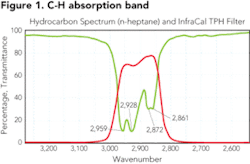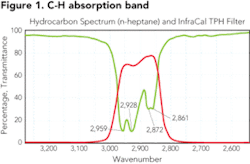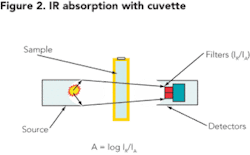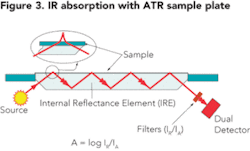By Sandra Rintoul
FOG and Sewer Overflows
It is estimated that 23% to 28% of sanitary sewer overflows (SSOs) are due to fats, oils and grease (FOG) or as much as 19 million gallons from 1998 to 2001 (State of North Carolina, 2004). Our increasingly mobile society has led to a decrease in cooking at home and a significant growth in the commercial food sector. This, in addition to other industries that already deposit oil and grease in the waste stream, contributes to the increase of SSOs.
As part of the Clean Water Act, industries discharging into Publicly Owned Treatment Works (POTWs) are facing new and stricter FOG regulations. Many are faced with limits of 100 ppm of oil and grease. These new limits are forcing industries to monitor their effluent more closely prior to discharge, which means more frequent measurements to ensure compliance.
For POTWs, an important feature of any FOG program is locating and monitoring industries and food service establishments dumping high levels of FOG in the sewer line. Waiting for remote laboratory results can add costs in both time and dollars. A new simplified procedure for FOG analysis based on solvent extraction and infrared absorption can give a regulator or operator an on-site result in less than 10 minutes.
Infrared Analysis
Infrared analysis of oil and grease has been used in the petroleum industry on highly regulated off-shore oil platforms for over 30 years. EPA Methods 413.2 and 418.1 are infrared methods for oil and grease measurement using now-banned Freon to extract the hydrocarbons from the effluent. EPA Method 1664, using hexane as the extraction solvent and gravimetric analysis, is now the standard method replacing Freon methods. This gravimetric procedure requires a skilled laboratory technician and is a time- and equipment-intensive process.
The ASTM passed an alternate method, D 7066-04, using a Freon replacement solvent (S-316) and simplified infrared analysis. There is also an alternate infrared method using hexane extraction and evaporation.
The measurement by infrared absorption makes use of the fact that hydrocarbons, such as fats, oil and grease, can be extracted from water or soil through the use of an appropriate solvent. The extracted hydrocarbons absorb infrared energy at a common infrared wavelength and the amount of energy absorbed is proportional to the concentration of the oil/grease in the solvent. This can be directly calibrated or converted to the amount of oil in the original sample.
Infrared Absorption and Solvent Extraction
For an infrared measurement, FOG is measured at the C-H absorption band at 2930 cm-1 or 3.4 micrometers (see Fig. 1). Either S-316 solvent, as called for in the ASTM method D 7066-04, or a spectroscopic, hydrocarbon-free grade of perchloroethylene is a good infrared solvent, as both totally lack a C-H absorption band.
The solvent extract is placed directly in a quartz cuvette. A beam of infrared light goes through the extract for an infrared transmission measurement (see Fig. 2) and the filter/detector set for C-H absorbance measures the hydrocarbon content in the extract. The minimum detection for this method using a portable fixed filter infrared analyzer is 2 ppm.
null
Infrared Absorption and Hexane Extraction
Since the EPA lists oil and grease as “hexane extractable material” in the new effluent limitation guidelines, it makes sense to use hexane as the extractant. Because hexane contains hydrocarbons, it must be evaporated off in order not to interfere with the infrared hydrocarbon measurement of oil and grease. This poses a problem for the traditional infrared method of using a quartz cuvette and transmission as described above. An alternate sample holder to the quartz cuvette is used: the attenuated total reflection (ATR) sample plate (see Fig. 3).
A measured amount of the hexane extract is deposited on the ATR crystal. The hexane evaporates and leaves a film of oil and grease. The infrared beam is internally reflected down the ATR crystal and the output is focused directly on the detector. Since there is an evanescent wave that penetrates the film of oil and grease at each internal reflection point, energy is absorbed at the C-H absorption band without the hydrocarbon interference from the hexane. The minimum detection for the ATR sample plate is 8 ppm.
Comparing Analysis Methods
FOG is a difficult analysis because it is not a unique chemical entity. The definition of FOG is dependent on the procedure and solvent used. Because different testing look at different physical properties of FOG, there can be differences in the analysis. At 3.4 µm, infrared is primarily counting CH2 groups so the infrared absorbance goes up with the length of the hydrocarbon chain, which correlates with the weight of the hydrocarbon. Therefore, the EPA 1664 Method and infrared analysis typically correlate well with each other.
Table 1 shows two sets of data comparing the hexane/infrared method to the hexane/gravimetric method. One data set is from a meat packing plant and the other from tests done on a grease trap from a restaurant. Taking into account that it is difficult to get two identical grab samples from a waste stream, the two methods correlate very closely.
Measurement Procedure
Advantages of infrared analysis are the ease of use and the quick analysis time. Portable, relatively inexpensive, fixed-filter infrared analyzers such as the Wilks InfraCal TOG/TPH Analyzer allow for on-site analysis for regulators or industrial pretreatment personnel. The extraction and measurement procedure involves several simple steps, allowing an operator with minimal training to do the analysis.
The sample is collected in a container. Hexane, perchloroethylene or S-316 is added at a ratio of one part solvent to 10 parts sample. After being shaken for 2 minutes, the hexane, which is lighter than water, will rise to the top carrying dissolved oil and grease with it. The S-316 and perchloroethylene are heavier than water and require an inverted container, such as a separatory funnel or a jar with a septum, to remove the solvent. The water and particulate matter is left behind so no filtering or drying of the extract is needed prior to analysis.
The hexane extract is placed on the ATR crystal and after evaporation (about 3 minutes) the result is displayed. The cuvette is filled with the S-316 extract and placed in the analyzer. After 30 seconds, the result is displayed. The analysis from sample collection to final result takes less than 10 minutes.
Only a small amount of extract is needed for analysis: using a 100 mL sample requires only 10 mL of hexane or S-316. This reduces solvent cost and disposal. Since hexane is a hydrocarbon, it can be returned to the pretreatment system for removal. S-316 can be reclaimed and reused. It should be noted that the gravimetric method requires a 1-liter sample and 100 mL of solvent and results in a relatively inaccurate mass estimate because of the error introduced by measuring a small mass change in a relatively massive container.
Conclusion
Using portable infrared analyzers with a simple and quick infrared procedure enables operators of a pretreatment system to easily assess a system’s efficiency. Plant operators have the advantage of taking samples before and after treatment to see how a system functions under heavy loads. System parameters can be changed and the results of the changes can be determined without waiting a week or more for a laboratory result. In addition, regulators from a POTW can immediately determine who their “FOG clog” offenders are and how much they are releasing into the sewage system. Most importantly, effluent that is above the fats, oil and grease regulatory limits can be stopped before it impedes the flow of the sewer line.
References
- Caudle, Dan D. Measuring Oil and Grease in Produced Water, Eighth Annual Produced Water Seminar, January 1998.
- Subcasky, Wayne J. Oil in Water Analysis Hexane/Gravimetric and Hexane/Infrared Methods, Eighth Annual Produced Water Seminar, January 1998.
- FOG Task Force. Considerations for the Management of Discharge of Fats, Oil and Grease (FOG) to Sanitary Sewer Systems, DPPEA-FY01-22, State of North Carolina, June 2002.
About the Author:
Sandra Rintoul has worked with infrared analysis for 30 years. Her experience includes assembly, service, technical support, applications support, product management and sales in a broad range of infrared applications, in particular oil and grease analysis. She chaired the ASTM committee for Method D 7066-04 and is currently product manager/technical support for the InfraCal TOG/TPH Analyzers for Wilks Enterprise.






